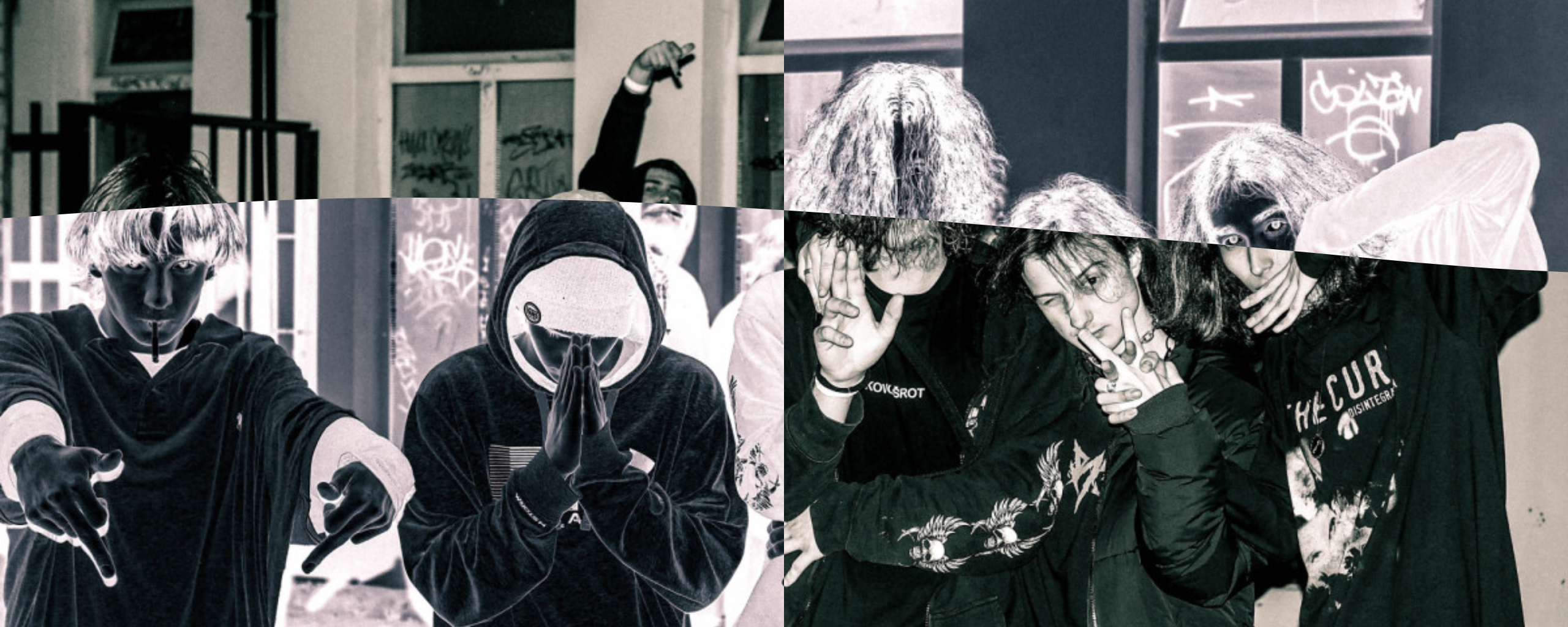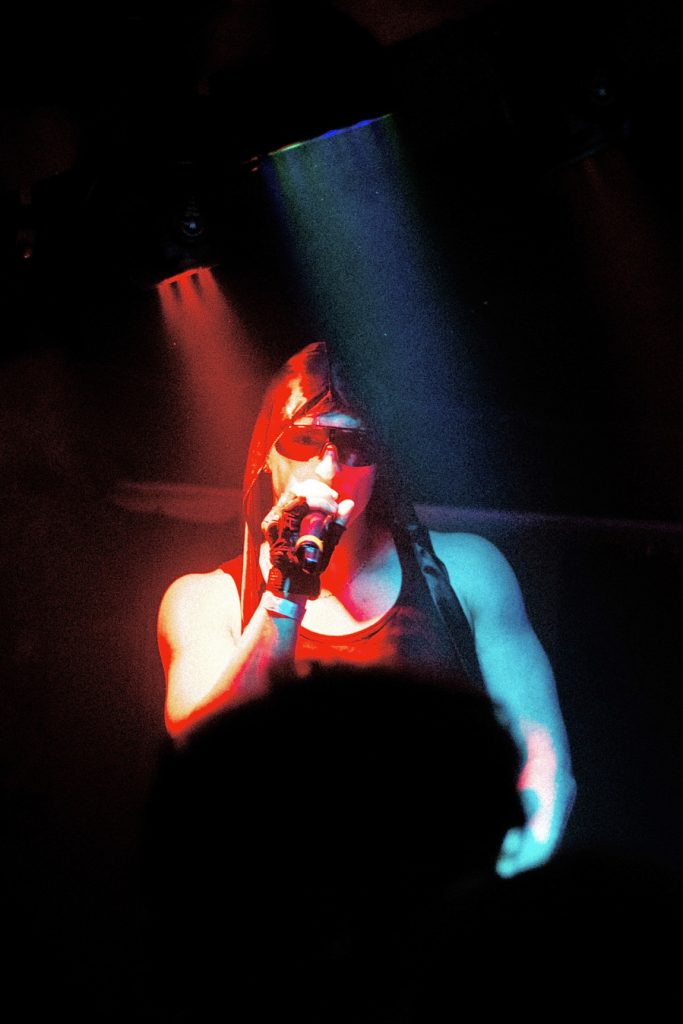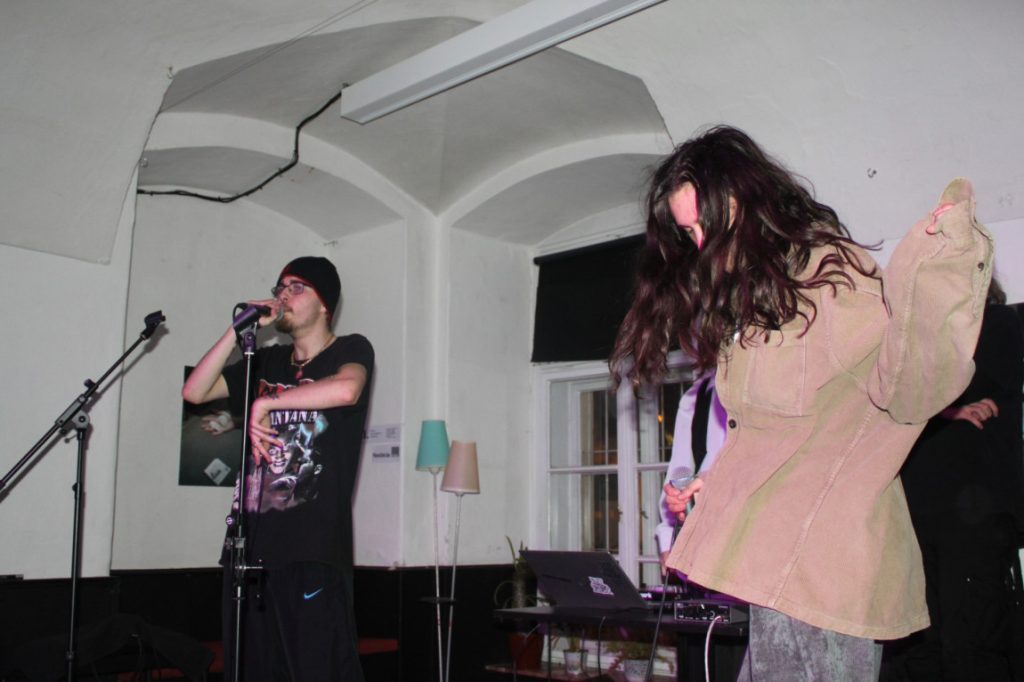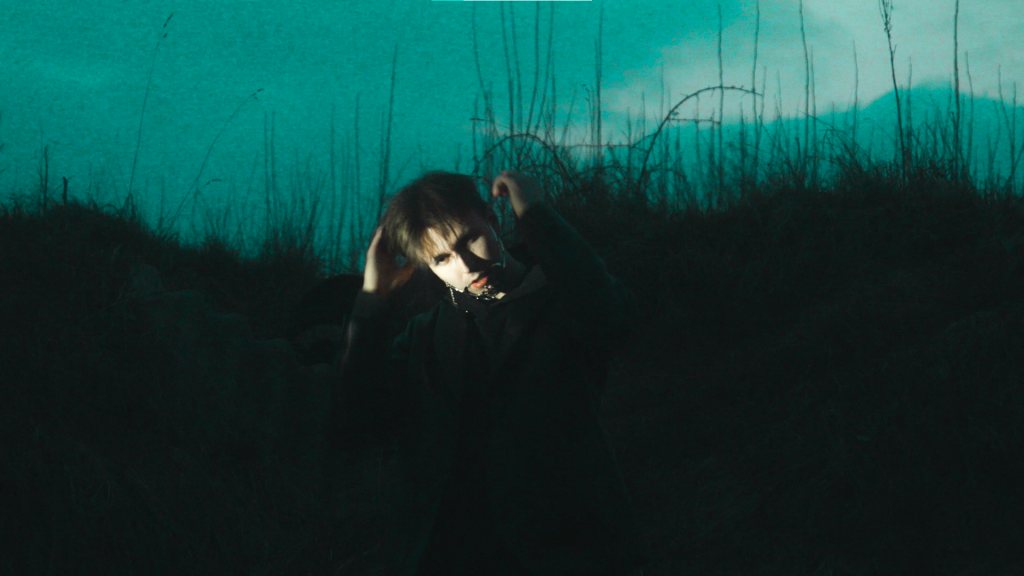The Digicore scene in Slovakia — How to make music and build community
Published July, 2024
by Easterndaze

It can be challenging to pinpoint the precise origins of hyperpop as a musical genre. The term was first used in the 1980s in connection with the Scottish band Cocteau Twins, but they can hardly be described as the predecessors, let alone pioneers of the genre. Its origin is mostly considered to be the establishment of the label PC Music, founded by British producer A.G. Cook in 2013. The label connected various names in experimental music, such as Sophie and Kero Kero Bonito, around whom the entire music scene later formed. The latter became more widely recognised in mainstream context thanks to frequent collaborations with artists like Charli XCX.
Over time, and in an era saturated by the online space and the global pandemic, hyperpop has become more of a movement than a musical genre. Only a few of today’s artists and performers resemble the sound of the original PC Music, which can be heard in the solo work of e.g. Sophie or 100 Gecs. Artists have swapped glitchy vocals for an emo-like voice, and the tempo often isn’t any faster than it is in other genres. The queer identity and initial inspiration from the surroundings of PC Music remain.
A.G. Cook probably couldn’t fathom the movement he would start with his over-the-top electronic pop. His label inspired an independent internet community and gradually initiated the emergence of another genre, digicore, which comprises thousands of other micro-genres. This is mainly due to the simplicity with which almost anyone today can release their music on pages such as Bandcamp or Soundcloud or discuss it on Rateyourmusic, Reddit or other forums. It has never been easier to receive feedback on one’s work.
Digicore is a micro-scene consisting mainly of teenagers producing music in cracked FL Studio software. They discuss their tracks on Discord during several hours of gaming sessions on League of Legends, Minecraft, or Rocket League. Digicore is complex and diverse, and it is challenging to describe it in detail, mostly due to the inspiration for it stemming from so many different genres. It also created a completely different “emo community”, not unlike the one from the end of the 1990s. This genre emerged during the global COVID-19 pandemic and grew exponentially during this period. Artists such as glaive, who published their first song on Spotify at the age of 15 in May 2020, are currently enjoying the attention of millions of listeners. glaive has recently signed a contract with a professional label.
The origins of digicore in Slovakia
It usually takes a while for global phenomena to reach Slovakia. Pop punk’s mainstream popularity peaked internationally in the early nineties, but it took another ten years for bands like Iné Kafe to emerge and imitate this sound. With Digicore, however, things were different. Although a relatively new genre, digicore is popular and widely represented in the Slovak alternative scene. The origins of this sound in Slovakia are, however, uncertain.
I would consider Dycember’s Love EP from February 2021 the first digicore project. At its release, Dycember was part of the Playground Collective, which also releases works by artists such as Trashbag Face and Goodnite Adam. The whole collective is inspired by cloud rap, especially the Swedish group Drain Gang. This is closely associated with digicore both in Slovakia and internationally to such an extent that Drain Gang is being listed as an inspiration by almost anyone currently labelled as a hyperpop artist in Slovakia.
Even though many people describe this music as hyperpop, I recommend avoiding that label. Although some attempts, especially from the initial creative phases of some artists, were close to hyperpop, they gradually developed into different genres. Their inspiration is not only Drain Gang; some are more intimately related to rap, shoegaze, and emo. As a result of this, the same scene, sharing the same fans and events, is inhabited by people unrelated musically but united in their shared DIY approach and origins of their creative work. Due to this, I would use the term “digicore”, which is similar to the whole scene, slightly more encompassing and, therefore, more precise.
Hyperpunk! – The Slovak digicore connection
The Slovak digicore scene has rarely been unified; even today, it still needs to be more cohesive. It is, therefore, challenging for uninitiated listeners to orient themselves in it. Most of these small groups met only during a series of Hyperpunk! events that ran from May 2022 to April 2023. The Hyperpunk! festival was recently established and also hosts artists outside of the digicore scene. At the same time, the current festival is the closest to the original events, as well as to the reunification of the scene.
“Hyperpunk! exceeded our expectations immensely. By bringing different scenes with quite different sounds together, it was difficult to sustain, but in my opinion, it felt like such a success for so many of us because it introduced us all to each other and helped artists reach an audience that was willing to give new music a chance” — said Hyperpunk! founder Zandome about the festival.
In the first event, Téčko joined the action, the second event featured razor.bl8, Adam The World and the Brokeway collective, the third event featured ph1l and Sugoi Kimono, the fourth event featured Sober, and the second series of events even featured Fvck_Kvlt. Over time, however, these shows gained a not-so-great reputation, and nowadays, many performers tend to distance themselves from Hyperpunk!. Several smaller series of events, e.g. Dystopia, Kataklyzma, and Stardust, closely reminiscent of the Hyperpunk! concept, take place for them instead. Through these actions, the fan bases and musicians became acquainted and started to work together.

“I definitely feel the legacy of Hyperpunk! as the original connecting element of the digicore scene. At the first Hyperpunk! events, I met friends with whom I had only interacted online before and with whom I probably would not have met otherwise. I also got to know young artists there, whom I currently consider my colleagues” — said Gemstonemario.
This opinion is, however, not shared by everyone:
“I would not label Hyperpunk! as the main connecting piece of the puzzle; it might have been, at the beginning, but after that, it divided the scene more than connected it” — opposed Sugoi Kimono, and he’s not alone.

However, the first digicore artist, Dycember, had no intention of creating digicore, nor was he a direct part of the Hyperpunk! events. At the time of the Love EP’s release, however, he worked more closely with and was also part of the Brokeway collective, which performed at Hyperpunk! events. It was formed in Ružomberok in late 2021 and wasn’t just a musical group at first. For example, graphic artists, designers, and photographers were also part of the collective. Overall, this collective has undergone numerous changes in the short period of its existence. From the original membership, only Grydo and Gemstonemario remained in the collective, accompanied by Nikolas Hudcovsky.
Brokeway, 00miracle and DCR OFF
Grydo is the most extravagant from the collective. He tapped into every existing genre on all three EPs he produced and created highly challenging music even for experienced listeners with his highly experimental sound. Gemstonemario has often changed his sound, but he is generally more extravagant with his rather very unusual beats. An excellent example is his cover version of Žbirka’s song “Do člna”, which he transformed into a gothic, glitchy hyperpop with extreme intensity.
As time passed, many musicians joined the collective; during one period, it comprised up to seven musicians, including Grydo, Gemstonemario, Nikolas Hudcovsky, Kodiki, dancimnau9, adusko and b4rshi + DJ Makkex. Kodiki was the first to leave, as a result of the shift of the focus of the collective from art to a purely musical project.
Initially, Kodiki derived inspiration predominantly from electronic genres (which will not be enumerated here); to simplify, they are branches of breakcore or drum’ n bass. Over time, his focus shifted from the original hyperpop to more glitch genres with quicker tempos. Currently, except for some events, he primarily plays subgenres of nightcore and future bass as a stable part of the Slovak DJ underground alongside Kristie Kardio or Transmisia.
The last and most significant change was the departure of the last three mentioned artists. Adusko and b4rshi have been closely connected since the beginning, creating music and sharing many collaborations. Adusko is currently more active and popular; unlike others, his source of inspiration is mostly alternative rock and genres such as shoegaze or emo. It becomes apparent in his latest projects, which have little in common with his former hyperpop work. Similarly to Grydo, adusko also creates his own music, the best comparison for which would be the scene around Jane Remover, alone; he is also active in a post-punk side-project strach z búrky.
Eventually, dancimnau9 left the collective as well. His consistent musical output made him the best-known Czechoslovak scenecore (a digicore subgenre) artist. On YouTube, tens of thousands of international listeners have played some of his songs. Scenecore is, aside from its rapid tempo, distinctive also by the lyrics. Often, they concern the community from which the genre originates, dancimnau9 together with others, predominantly artists based in Eastern Slovakia, created the 00miracle collective. mewxi, who, during their short career, managed to create a dedicated fanbase, also belongs to it.
00miracle often collaborates with the young Žilina collective DCR OFF, headed by Lil Zay, m1siak and sxtlean. The exciting aspect of this collective is the profoundly unserious nature of their lyrics and aesthetics, which are consistent with the musical stereotypes of the Slovak digicore scene.
In terms of fashion and attitude, they are inspired by the new emo scene; vocals are overlayed with effects on the backdrop of rapid beats. 00miracle initially created works in the entirely ironic semi-genre Roblox core. It started as music created by thirteen-year-olds and was then shared via the Roblox channel (the genre would deserve an article on its own). It can be briefly characterised as music with minimalist sound design, sophisticated beats and highly ironic lyrics. Lil Zajo used to be very active on TikTok, creating successful promo videos for his music.
The Kremnica scene and today’s Hyperpunk!
Another phenomenon came out of TikTok, which is undoubtedly the furthest from digicore and hyperpop. Inspired by the American rapper Playboy Carti’s Opium label, but especially by the rapper Yeat, ala6in and borismonstrum quickly rose to the forefront of the internet scene. Names which are well-known to average TikTok users under 20, mainly due to their ironic self-promotion. Recently, they started touring with an artist who is the most associated with the digicore scene, Sugoi Kimono. Nevertheless, they remain the most disputed and distant members of the scene.
Sugoi Kimono is sonically extremely distant from digicore and hyperpop. The only thing connecting him to them are the eccentric beats from his early work. Paradoxically, he has many tracks with ph1l, the only artist whose work can be characterised as Slovak hyperpop. Thanks to ph1l’s more electronic sound, together with Sugoi, they managed to play at the Hyperpunk! event and, through this, join the surrounding community.

Similarly, through cooperation with Samm734, the community was joined by the Kremnica scene around the artist Adam The World. Adam also paints and creates a generally poppier sound. His last album, počujem farby, sounds like a Slovak equivalent of “Blonde” by Frank Ocean. His work is simultaneously more compact than the rest of the scene. He managed to release three albums and created music long before digicore emerged. His most frequent cooperator is Vrillton, who mostly produces Chicago Drill inspired music and who the Slovak underground rap scene views as one of the most promising names in Slovak rap. He is often mentioned in the rap podcast Zip, and Doublecup at Radio Punctum; his new tracks are featured in most episodes, usually receiving positive reviews from Kabal and Edúv Syn.

Samm734 still operates on the border between the Kremnica micro scene and Hyperpunk! Musically, his work is the closest to the mainstream, which explains the high number of tracks above 100k streams on Spotify and the major musical collaborations. Currently, he is featured on Gleb’s new album Dlhá cesta domov (2024). Samm734 has gradually outgrown the Hyperpunk! musical collective and currently comprises Zandome, Mishino, Gapex, Muris and Samm734. Mishino initially chose the pop-punk route, deriving inspiration from the scene around MGK and Willow. Unlike the rest of the group, Mishino’s pop punk never sounded insincere or commercial, which is frequently mentioned by critics. Mishino gradually shifted towards post-punk aesthetics.
Worth mentioning are the few producers operating on the scene, one of them being the main producer of the members of Hyperpunk! Muris, whose beats are also favoured by Dušan Vlk. Muris also worked on the expressive beat of his hit track Ventolin. A large part of the scene has also worked with Lukemag, who possesses extensive knowledge of music, including jazz, rap, and the digicore scene. He creates experimental, highly conceptual music.
Hyperpop and its overlap with mainstream musical production
As soon as a particular scene starts gaining popularity, more established artists begin taking notes. In Slovakia, Fobia Kid tried to replicate the digicore sound. When this stable fixture of the rap scene released the highly autotuned hyperpop track “OK Boomer” in March 2021, reminiscent of 100 Gecs’ controversial track Money Machine, it divided his fanbase. However, no-one expected Fobia Kid to fully embrace the sound.
First, he released a vampiric conceptual hyperpop album Strašidelný Dom, after which he started to invite ph!l and Sugoi Kimono to open his shows. It all culminated with the track Gothic Outfit, the chorus of which is sung by Samm734. The clip features other members of the Slovak digicore community.
The musical output of one of the currently most important Slovak performers, SIMILIVINLIFE, could also be considered hyperpop. In 2021, he shifted his attention from rap to electronic music, heavily utilising effects, and his latest EP embraced this sound even more thoroughly. Despite being a fan of Sugoi Kimono, whom he referenced in the interview at Óčko, his connection to Slovak digicore is not that palpable. This part of the interview contains one of the most interesting perspectives on the Slovak digicore scene from the outside.
In the alternative scene, the duo Zaffer 9 has recently started to operate, and they can be viewed as the only pure, authentic Slovak hyperpop despite not being a part of the local digicore scene.
Toxic masculinity, gender inequality and queer identity
A distinct and easily observable phenomenon in the Slovak digicore scene compared to the ones abroad is the absence of female representation and gender diversity. The only female artist in the digicore scene is the rapper Sabskis – and not only is there a lack of female representation in a scene that has perhaps the most gender-diverse people among its fanbase worldwide, with many fans and artists identifying as queer – in the Slovak digicore space, the lyrics are also often quite macho, objectifying, and materialistic, too. Though it must be said that this is only true for a certain percentage of the scene.
The question arises whether to attribute this phenomenon to social factors, to the acceptance of these themes in modern rap (to this day, some artists still do not avoid these themes in foreign trap), or whether it is a purposeful ignorance or a form of meta-irony. Nevertheless, most digicore artists are very progressive in their opinion, as the lyrics themselves prove.
“I’ve always viewed music as a space to express myself. Be it some form of personal expression or, more recently, a platform for social commentary. I started with music when I found painting limiting and felt that music would be the perfect medium to express myself more sincerely” — says Adam The World.
For others, such as Sugoi Kimon, creating art is a hobby, “it is still just a hobby for me; otherwise, I probably would not even enjoy it” — he says. Motivations to create vary – most see it as a leisurely pastime and a form of self-expression.
The initial impulses for the creative process
“I do not make hyperpop” — claimed most of the artists I interviewed. They distance their work from hyperpop, or claim that they were just starting out in hyperpop stylistically, or consider it a label that they absolutely do not understand, and that’s why they don’t feel like they are part of this scene. This phenomenon can mainly be felt in connection with Hyperpunk! events. They tied together several tiny scenes at the beginning, for which most people are more or less unanimously very grateful, but after less than two years, part of the community refused to identify with Hyperpunk! for various reasons. In an attempt to understand this, I was unable to identify a reason most people agreed on – many respondents often were not even able to give a specific answer, or their answers were diametrically different.
“In the beginning, I saw myself as part of the digicore scene; now, I probably do not. I have many friends from there and have met many talented people through it. However, nowadays, sonically and aesthetically, my work is completely outside of that bubble. So I guess I do not feel part of a scene anymore” — says Adusko in summary of his stance.
Even though I refer to the scene as digicore, many male and female performers do not consider the genre as their inspiration. Most see the origins of their sound in various other corners of the music scene, from Yung Lean or Kanye to Mingus, Drain Gang and the Haunted Mound. Zandome, for example, hardly follows the digicore scene.

“I am inspired by Stromae, Linkin Park, Oliver Tree, Grandson and others. Stromae showed me how to make meaningful pop music . Pop is what I am into the most at the moment, but I also have harder stuff in my drawer. I think my strengths are lyrics; I want to use them to their full potential” — he says.
For others, however, digicore is an inspiration. “Ignoring my previous projects, which few people know about anyway, I am mostly into Jane the Remover. Her whole artistic progression is very inspiring to me” — Adusko says.
As for inspirations, dancimnau9 even refers to more specific subgenres, “I have always enjoyed fast and energetic music that invites one to move and completely occupies one’s mind. At the same time, I create scene-core probably because I don’t think my voice is strong enough for other genres. In the beginning, my main inspiration was oaf1, then later, m1v and nowadays, after fully immersing myself in the scene-core genre, it’s rylorie, qtae, skypebf, zeija and many others.“
It is also important to add that for many, the initial impetus for creation was not just the discovery of the genre itself but the social conditions that spurred the emergence of digicore abroad, namely the global pandemic and the economic crisis. Many of them mentioned that they support the DIY approach, and that digicore can be done on an absolutely minimal budget.
“I have been making music since I learned how to talk. The quarantine period only reinforced that, as I had more time for music” — says Lukemag. Muris, too, considers the excess of free time as the reason for the beginnings of his work. “I was also making music before Covid, but I stumbled upon hyperpop/digicore during Covid, probably somewhere on TikTok. I even told myself that it was a form of punk, as there seem to be no rules in digicore. They are genres that I can still take musical inspiration from or a particular element that I implement into a beat with a completely different energy.”
The Covid-19 lockdown was also an impetus for artist Lil Zaja’s work. “Personally, although I did not start making music until after the pandemic, I was initially inspired by the digicore scene that came out of the pandemic. However, nowadays, I am trying to move beyond genres like digicore/robloxcore as I see them as limiting genres where I do not see much room to improve and experiment” — he says.
The fluid scene
The Slovak digicore scene hasn’t really defined its boundaries very clearly yet. Each member of the scene perceives it differently; some claim to not even perceive it – so it’s unsurprising that if you are not, at least to some extent, its member, you can get lost in it easily. Despite its short existence, toxic masculine overtones and avoidance of genre categorisation, it can be said that digicore has built a community around itself that is loyal and friendly. A community in which there are many different groups and in which art directly interacts with its fans. The whole scene works on a friendly basis, and that’s also why you can feel a huge amount of acceptance and tolerance in it, one that many teens have found.
However, specific issues persevere. Its coherence has decreased since the beginning, and interpersonal conflicts between members have increased, causing a lack of interconnectedness with the Slovak alternative music scene. In addition, its existence remains unknown to many, and its affiliation with the Slovak alternative scene is disputed. This can, however, change in the future.
This article is a result of the personal observation of someone affiliated with the digicore scene since approximately the second Hyperpunk! event. I wrote it as an attempt to have as broad a scope as possible, remain as impartial as possible, while in dialogue with the interviewed artists. The dynamics of the digicore scene are very intense. Artists emerge, join, then disconnect. As a result, this text merely captures a moment in its development, opening the doors towards a seemingly unapproachable community.
— — — — —
Originally by Matej Žofčín for 3/4. Translated from Slovakian by Terézia Klasová. Edited for clarity.
This article is brought to you as part of the EM GUIDE project – an initiative dedicated to empowering independent music magazines and strengthen the underground music scene in Europe. Read more about the project at emgui.de.
Funded by the European Union. Views and opinions expressed are however those of the author(s) only and do not necessarily reflect those of the European Union or the European Education and Culture Executive Agency (EACEA). Neither the European Union nor EACEA can be held responsible for them.